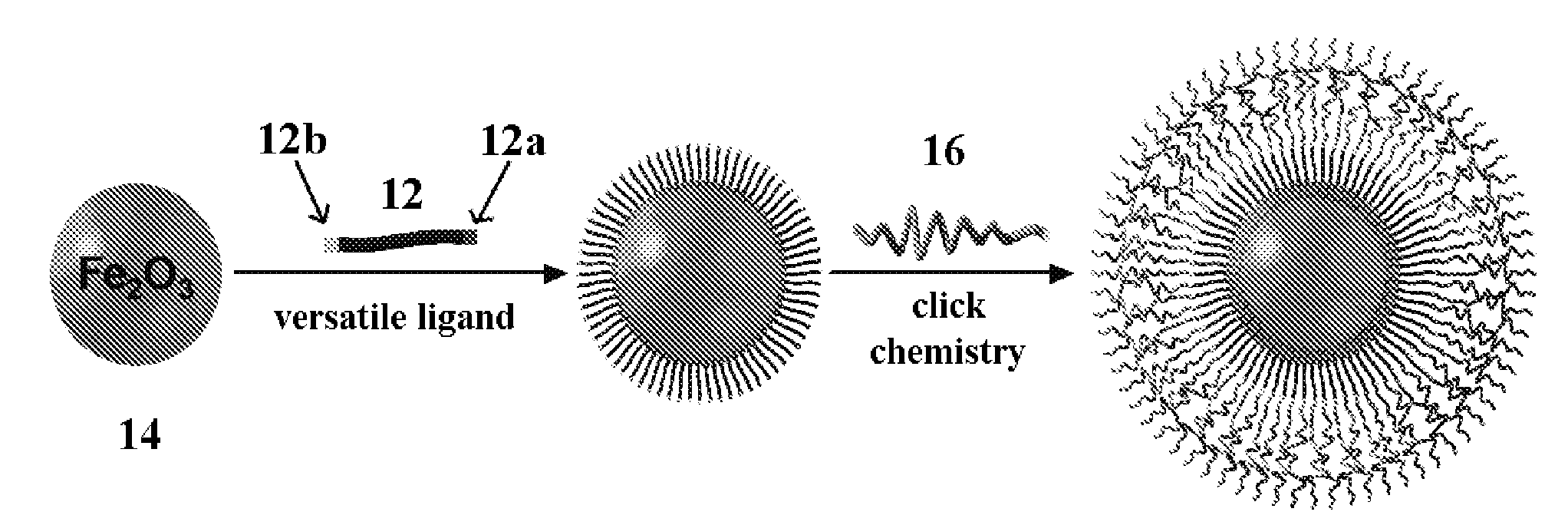Methods for controlling surface functionality of metal oxide nanoparticles, metal oxide nanoparticles having controlled functionality, and uses thereof
a technology of surface functionality and metal oxide nanoparticles, which is applied in the direction of drug compositions, group 5/15 element organic compounds, iron organic compounds, etc., can solve the problem of not being easily employed in a wide variety of applications
- Summary
- Abstract
- Description
- Claims
- Application Information
AI Technical Summary
Benefits of technology
Problems solved by technology
Method used
Image
Examples
example 1
[0058]γ-Fe2O3 nanoparticles having oleic acid ligands were synthesized as described in Yin, M., Willis, A., Redl, F. Turro, N. J., O'Brien, S. P., J. Mater. Res. 2004, 1 vol. 9, p. 1208. The nanoparticles are crystalline and well dispersed and have about less than 5% rms variation in size.
[0059]A versatile ligand was synthesized as follows. Anhydrous ethylene glycol (225 mL, 4.1 mol) was added to a 500 mL 2-neck round bottom flask that had been flame-dried under vacuum and purged three times with argon. The flask was equipped with a magnetic stir bar and rubber septum. The flask was then cooled to 0° C. for 3 hours. The reaction was quenched with 100 mL H2O and extracted with CHCl3 (3×100 mL). The combined organic extracts were dried over MgSO4, filtered, and the CHCl3 was removed by a rotary evaporator. The subsequent liquid was purified by distillation (85° C., 30 mTorr) to yield 2-bromo-2-methyl-propionic acid 2-hydroxy-ethyl ester as a viscous, clear, colorless liquid (30.4 g, 8...
example 2
[0070]γ-Fe2O3 nanoparticles having oleic acid as a ligand were synthesized as described in Yin, M., Willis, A., Redl, F. Turro, N. J., O'Brien, S. P., J. Mater. Res. 2004, 19, 1208. The nanoparticles are crystalline and well dispersed and have about less than 5% rms variation in size.
[0071]The oleic acid was stripped from the nanoparticles and exchanged with 5-hexynoic acid ligand (purchased from Aldrich) to obtain nanoparticles having 5-hexynoic acid ligand 108 (see FIG. 3) as follows. A 1:1 weight percent ratio of 5-hexynoic acid:Fe2O3 was added to a centrifuge tube. Approximately 5 mL of hexane was added to the nanoparticles. The resultant mixture was then sonicated for 20 minutes until the particles appeared to be dispersed. Ethanol was then added to the solution of particles until the mixture became cloudy to remove excess 5-hexynoic acid that was not attached to the surface of the particles. The mixture was then centrifuged, and the precipitate was collected while the supernat...
example 3
[0081]γ-Fe2O3 nanoparticles having oleic acid as a ligand were synthesized as described in Yin, M., Willis, A., Redl, F. Turro, N. J., O'Brien, S. P., J. Mater. Res. 2004, 1 vol. 9, p. 1208. The nanoparticles are crystalline and well dispersed and have about less than 5% rms variation in size.
[0082]The oleic acid was stripped from the nanoparticles and exchanged with a phosphonic acid ligand 102 to obtain nanoparticles having phosphonic acid ligand 102 (see FIG. 4) as described above in EXAMPLE 1.
[0083]An α-acetylene-poly(tert-butyl acrylate) (ptBA) polymer 114 was prepared by atom transfer radical polymerization (ATRP) as follows: CuBr (168 mg, 1.17 mmol) and 2-propynyl 2-bromo-2-methylpropanoate (240 mg, 1.17 mmol) were added to a clean, dry round bottom flask, which was subsequently evacuated for 15 minutes and back-filled with argon. Freshly distilled tert-butyl acrylate (11.4 g, 88.9 mmol) was added via a degassed syringe followed by degassed toluene (5.7 mL), and PMDETA (1.95 ...
PUM
| Property | Measurement | Unit |
|---|---|---|
| dielectric constant | aaaaa | aaaaa |
| dielectric constant | aaaaa | aaaaa |
| dielectric constant | aaaaa | aaaaa |
Abstract
Description
Claims
Application Information
 Login to View More
Login to View More - R&D
- Intellectual Property
- Life Sciences
- Materials
- Tech Scout
- Unparalleled Data Quality
- Higher Quality Content
- 60% Fewer Hallucinations
Browse by: Latest US Patents, China's latest patents, Technical Efficacy Thesaurus, Application Domain, Technology Topic, Popular Technical Reports.
© 2025 PatSnap. All rights reserved.Legal|Privacy policy|Modern Slavery Act Transparency Statement|Sitemap|About US| Contact US: help@patsnap.com



